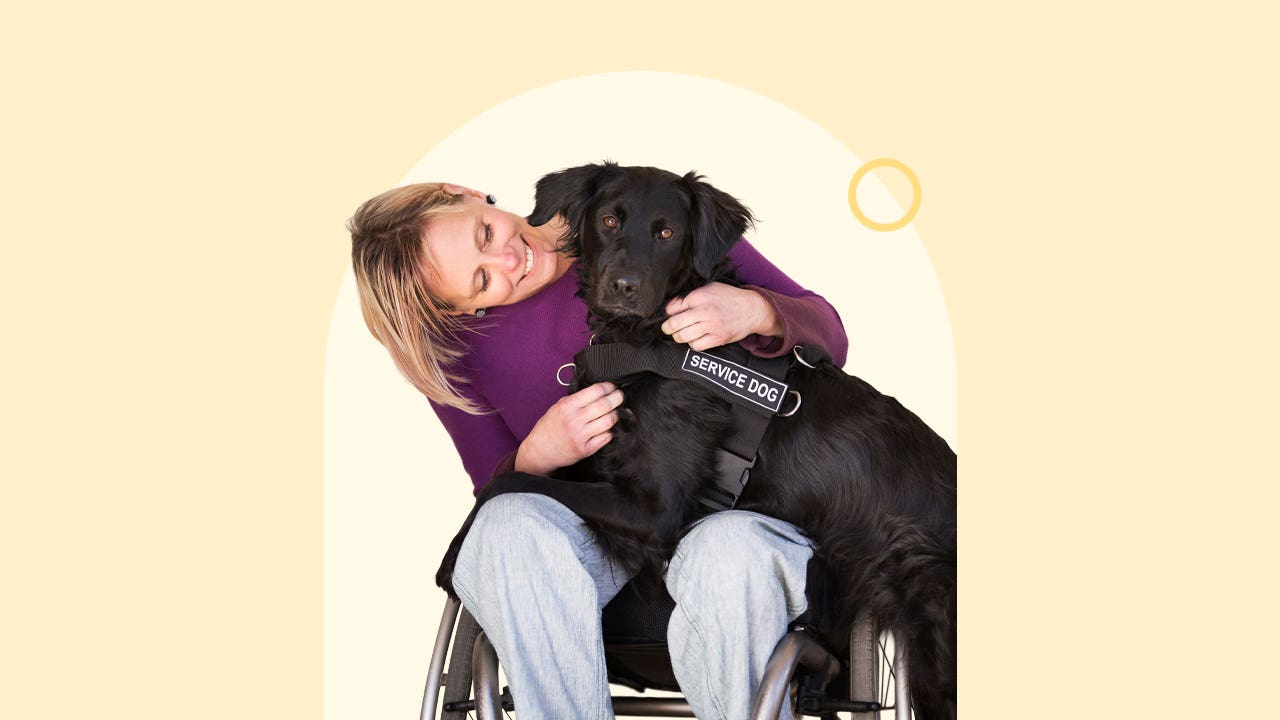Life-changing companions: How to afford a service dog

Key takeaways
- Trained service dogs cost between $10,000 and $30,000 on average but can go as high as $50,000.
- Before getting a service dog, consider the associated costs, such as training, food, trips to the vet and care.
- If you cannot use a program, consider a personal loan, grant FSA account or fundraiser to get the funds.
Service dogs can change the lives of those who need them. They are specifically trained to help individuals living with physical, psychiatric, intellectual or sensory disabilities. To become service animals, these animals must pass multiple stages of proficiency training, making them an expensive (yet often necessary) resource. The average cost of getting a trained service dog in the U.S. is between $10,000 and $30,000, with high-skilled service dogs costing as much as $50,000. The high price tag makes it necessary for many to seek financial help when getting one.
Multiple organizations offer scholarships and service dog grants to those who qualify. You can also take advantage of financing options, like loans or repayment plans, to tackle the costs associated with owning and training a service dog.
How to get a service dog
If you’re ready to find your new companion, start with these steps:
- Determine your eligibility. While exceptions exist, you may need to meet certain medical criteria to qualify for a service dog. Your condition may also determine the breed of dog you should look for. Talk with your healthcare provider or consult your medical team if you’re unsure of which breed would best meet your needs.
- Find a program. Many programs match people with service dogs, and most specialize in certain medical conditions or needs. The programs listed on this page are a good place to start and remember, it’s always best to compare a few different providers.
- Determine if professional training is necessary. You may also choose to put your own dog through training, which takes the guesswork out of being partnered with a new dog. However, this method may be more time-consuming and expensive due to the training costs. It takes between six months to a year (over 120 hours) to properly train a service dog, a trainers charge an average of $150 to $250 per hour, although this can vary.
- Gather supplies. Before your service dog comes home, you’ll want to prepare your living space with dog food, toys and other pet supplies. You may also wish to get service dog certification. This certificate is optional, but you may carry it publicly and show it to inquirers instead of explaining your condition.
The importance of service dog accreditation
Sarah Mathers, the former development assistant at Patriot PAWS Service Dogs, urges anyone in the market for a service dog to use organizations accredited by Assistance Dogs International (ADI). This accrediting body sets industry and worldwide standards for individuals who train dogs.
“ADI Standards are the benchmarks for excellence in the assistance dog industry,” says Mathers.
ADI accreditation requires service animal programs to meet administrative and facility standards. Standards include:
- Operating as a nonprofit organization.
- Demonstrating financial transparency.
- Maintaining hygienic kennels and training facilities.
The ADI also sets standards for respectful communication with disabled clients and ethical and humane handling of dogs under their care.
You are not required to go through an ADI-accredited program to get a service dog. However, doing so ensures that the service dog received the care and comprehensive training needed to successfully serve your needs. It also helps ensure a good match between a service dog and its handler.
Ways to pay for a service dog
While service dogs can be an investment, they have the power to change lives. Patriot PAWS’ veteran coordinator, Aaron Mixell, is an Army veteran who was seriously injured by an IED blast that left him with traumatic brain injury and debilitating post-traumatic stress.
“As a result of his PTSD, Aaron was literally living in his closet,” Mathers says.
“Mixell and his service dog, Chief, have been a team for about four years now, and Aaron is a completely different person,” Mathers adds. “He would tell you that Chief saved his life.”
Saving for a service dog’s initial costs and subsequent upkeep can be overwhelming. That’s especially true if you are worried about losing access to Supplemental Security Income by exceeding asset limits. But the assistance you’ll receive has the potential to be life-changing.
Before writing off a service dog due to the costs, research your options. You may be eligible for partial or full financial assistance.
- Personal loans: Unlike grants or fundraisers, personal loans must be repaid. However, you may be able to find loan amounts high enough to cover the costs of adoption, training and vet visits, even if you have bad credit. Just keep in mind that a dog is a long-term investment and will require food, vet visits and other costs. It is unwise to put yourself into debt by taking on an investment like this unless you feel certain you will be able to manage the loan and afford your dog’s needs.
- Service dog grants: Several organizations provide grant assistance for individuals who need a service dog. For example, the United States Department of Veterans Affairs (VA) provides service dog benefits and matches vets with accredited organizations. Nonprofit organizations nationwide also train and match service dogs with people in need.
- Fundraising: Some organizations provide partial financial assistance for the cost of service dogs and encourage families to fundraise the remaining amount in their community through various channels.
- FSA accounts: You can use a flexible spending account (FSA) attached to your insurance policy to buy a service dog if you get a letter of medical necessity (LMN) from your doctor.
Costs of getting and owning a service dog
There are several costs to consider when deciding whether to get a service dog.
- Cost of a service dog: The exact cost of purchasing a service dog varies by breed but can be anywhere from $10,000 to $30,000. Some service dogs can cost far more, as much as $50,000.
- Ongoing costs: Annual costs associated with caring for your service dog include food, vet visits and checkups, vaccinations, toys and training. All of these things can add up. Owners can expect to spend around $1,200 or more, depending on their dog’s size, breed and temperament.
- Training: You can expect to spend from $150 to $250 per hour on a professional dog trainer. The final cost will depend on how much time it takes to fully train your dog. The tasks your dog must learn will also impact the overall price tag. More complex tasks take longer to learn, meaning more training fees. Depending on the required task and the temperament of your pup, training can take up to two years to complete.
For many individuals who need a service dog, these costs might be out of budget. However, several organizations provide free or partial financial assistance. These organizations may also provide alternative methods of financing a service dog, even if you don’t meet the requirements to receive full financial assistance.
Programs that provide complete or partial financial assistance
Finding the best organization for your specific area and needs is important. Below is a list of fully accredited organizations, programs and grants that can help. For a geographical search of all accredited service dog organizations, visit Assistance Dogs International and enter your exact geographical location.
Other financing options to consider
If you still need assistance after exhausting all of your financing options, consider the following:
- Adopt: If you don’t qualify for full financial assistance, you can adopt your dog and use a certified independent trainer. This can help to offset some of the larger costs that come with relying on one organization for the entire process. But remember that there’s no guarantee of training success with your dog. Speak to an expert or to your care team before selecting a breed.
- Seek help from an organization: If you need pet financial aid, several organizations and resources offer assistance for pet owners who need help with vet bills and other expenses. Check out the Humane Society website for more information.
- Find ways to lower the costs: The IRS allows you to claim service dogs on your taxes, including dog purchase, maintenance (food, veterinary care and grooming) and training costs. Certain dog food companies, such as Darwin’s Natural Pet Products, offer discounted rates for service dogs. Likewise, veterinarians often offer discounts to individuals with service dogs. Ask your veterinarian for more information.
Types of service dogs
Service dogs are not one-size-fits-all. Each dog is trained to help individuals with different needs. Here’s a quick breakdown of the most common types of service dogs and their specific skill set.
Bottom line
If you plan to adopt a service dog, there are several ways to make the process more cost-effective. However, you’ll need to make sure you have funds to support your new furry friend.
While grants and programs are available to make service dogs more affordable for those in need, owning a dog is a financial responsibility in its own right and will come with long-term expenses you’ll ultimately cover yourself. Consult your medical team and review your finances when deciding whether getting a service dog will be financially worthwhile.
You may also like

Life insurance for people with high cholesterol

Does pet insurance cover pre-existing conditions?

The ultimate guide to roadside assistance



